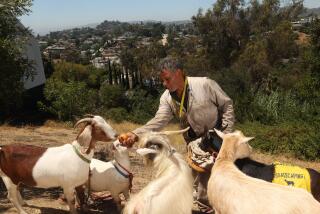A backyard battle against squirrels
In 1904, when soldiers from the Civil and Spanish-American wars settled into the Veterans Home in West Los Angeles, they brought Eastern fox squirrels with them as pets (or possibly as future dinners) from Kentucky and Tennessee.
Last week in the Toluca Woods section of North Hollywood, Beverlee Nelson’s prized apricot crop was nearly destroyed.
What’s the connection?
The squirrels got loose in 1904, according to a recent blog post by Lila Higgins of the Natural History Museum in Exposition Park.
The vets’ squirrels had to eat, and that became a problem, Higgins wrote last month, citing research from museum mammalogist Jim Dines. “Eventually an overzealous hospital administrator noticed that they were being fed table scraps and, deeming this illicit provisioning a misuse of government support, turned the squirrels loose.”
The squirrels have since marched north to Oxnard, south to Orange County and east to Ontario. They are so bold, Higgins told me, they have been seen swiping French fries and sandwiches from kids on field trips to the Natural History Museum. In her blog, Higgins says a camera has been planted in a peanut to further study the habits of the thieving squirrels, so be sure to look for footage from the Peanut Cam when it’s launched. In the meantime, you can find updates at https://northcampusnhm.blogspot.com/.
But let’s get back to Toluca Woods and the embattled Beverlee Nelson, a retired school district clerical worker who wants nothing more than to live in peace, tend to her lovely garden and make apricot jam. Pray for her, please.
Attacks on Nelson’s crops have escalated for several years, and this spring has been awful, with a family of four fox squirrels feasting on the backyard bounty. Nelson contacted me in desperation, as many people do, because of my years of combat with another backyard pest, raccoons.
The squirrels take just one bite out of Nelson’s apricots and knock them to the ground in the process of this gluttonous orgy, with fruit flies swarming over the carnage. The apricots still on the tree aren’t ripe yet, so Nelson can’t pick them. No deterrent has worked.
“I have tried foil pans” (tied and hanging from branches), “loud music, water hoses, mothballs in stockings, and lastly my neighbor’s trap with peanut butter.”
The trap almost worked.
“I heard the trap door go down and ran gleefully to the yard. There sat the squirrel, on the picnic table, eating his peanut butter sandwich, OUTSIDE the trap! Grrrr.”
I arrived on the scene at 10:05 one morning last week. Nelson had counted 150 more lost apricots fallen to the ground already that day, and she was in a state of mild shock. She had finally trapped a squirrel after more than a week of efforts, only to see the squirrel nose up the trap door like Houdini and escape.
When we walked into the backyard, one of her tormentors sat outside the trap on top of the picnic table as if he were on a break. The squirrel was not intimidated at all by our presence. He sat upright, eating the bait — this time cheese bread from Albertson’s — as if taunting us to try something.
I moved in closer, and the squirrel ran back into the trap.
“You brought good luck!” Nelson squealed as her neighbors, Cesar and Virginia Garma, moved in to eyeball the catch. They live across the street, where squirrels destroy their pomegranates and oranges. Cesar, a retired engineer, has resorted to crafting individual mesh cages to protect every one of his precious pomegranates.
Clearly, battle fatigue has set in here in Toluca Woods.
Cesar Garma secured the lock on the trap and volunteered to transport the little beast to Bob Hope Park. The trapped squirrel yipped and yapped and tried to bite through the steel mesh of his trap.
“I feel kind of bad about breaking up the family,” Nelson said as two more squirrels watched from the roof of her house.
That’s just what the squirrels want to hear. You can’t go soft now, Beverlee.
Unfortunately for Nelson, power lines run through her tree and the roof of her house is inches away, meaning there’s no way to cut off the squirrels’ access. So it wouldn’t help to put a band of sheet metal around the trunk, and no matter how many squirrels she traps, backup troops are sure to move in behind them.
I phoned a guy who calls himself Trapper Trevor, and he said he’d charge $140 to set traps for two weeks and $70 for each squirrel he disposes of. But he and his team of eight trappers are busy right now with another problem. All over Southern California, raccoons are having babies in attics, driving homeowners crazy.
It’s a jungle. And the law is not on the side of humans.
Rebecca Dmytryk of WildRescue, a nonprofit dedicated to wildlife preservation, told me no homeowner can trap a wild animal in California without written permission from every neighbor within 150 yards. And, she said, you can’t relocate a non-indigenous animal that you’ve trapped, because it might then compete with a native animal — such as the Western gray squirrel.
So what are you supposed to do?
“You can legally euthanize,” Dmytryk said.
Here we are, back to squirrel stew.
“As long as you legally trap it and legally, humanely euthanize it and it has been deemed a pest species.”
So let’s review: You can trap and kill a squirrel, but not release it into a park? By the way, how do you humanely kill a squirrel?
You might shoot it, Dmytryk said, or use “blunt trauma to the head.” Yeah, that sounds humane.
Beverlee Nelson is no Beverlee Hillbilly, so I don’t see her going Jed Clampett.
But the squirrels have become an obsession with her now, and I’m putting my money on Nelson to make jam again. If not this year, then next.
“I’m 73 years old,” she said, “and I’m going to get through this before I’m gone.”
More to Read
Sign up for The Wild
We’ll help you find the best places to hike, bike and run, as well as the perfect silent spots for meditation and yoga.
You may occasionally receive promotional content from the Los Angeles Times.











